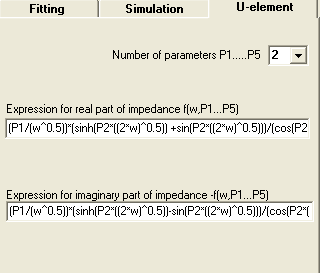
Menu

Toolbar

Constraints/Results

Impedance Spectra

Equivalent Circuit

Settings

|
|

 EIS Spectrum Analyser
Help
EIS Spectrum Analyser
Help
User-Defined Element (U-element)
Use the U-element only when the expected dependence cannot be represented
with the predefined elements, the predefined elements work much faster.
1. Add an U-element to the Equivalent Circuit panel and click the U-element page control in Settings panel.
2. Select the number of parameters required in the model (up to five parameters in Beta version).

3. Define the U-element impedance dependence on frequency: type an expression for real part of impedance into the ReZ box and the corresponding expression for the negative of imaginary part of impedance into the ImZ
box (omit the imaginary unit). Use “w” for the circular frequency, P1,
P2… for parameters. The following operators and functions are allowed:
* Multiplication
+ Addition
/ Division
- Subtraction, negative value
^ Exponentiation
cos() for the cosine
cotnh() for the hyperbolic cotangent
sin() for the sine
tan() for the tangent
cotn() for the cotangent
arctn() for the arctangent
cosh() for the hyperbolic cosine
arcsn() for the arcsine
sinh() for the hyperbolic sine
arccn() for the arccosine
tanh() for the hyperbolic tangent
ln() for the natural logarithm
log() for the common logarithm
exp() for the exponent
use pi for π-constant
Use round brackets (nested round brackets also may be used) to define sequence of operations.
Use the decimal point to enter non-integral numbers.
“E” may be used for a power of 10, e.g. 2E-5.
Example. Capacitor has no real impedance and has -1/(w*C) imaginary impedance. To determine an U-element equivalent to the capacitor, select 1 for the number of parameters, type 0 in the ReZ box (expression for real part of impedance), type 1/(w*P1) in the ImZ box (expression for imaginary part of impedance, “-” omitted).
Two more examples:
CPE as U-element:
Re[Z] = (1/(P1*w^P2))*cos(P2*pi)
Im[Z] = (1/(P1*w^P2))*sin(P2*pi)
Warburg short (Ws) as U-element:
Re[Z] = (P1/(w^0.5))*(sinh(P2*((2*w)^0.5)) +sin(P2*((2*w)^0.5)))/(cos(P2*((2*w)^0.5)) + cosh(P2*((2*w)^0.5)))
Im[Z] = (P1/(w^0.5))*(sinh(P2*((2*w)^0.5)) - sin(P2*((2*w)^0.5)))/(cos(P2*((2*w)^0.5)) + cosh(P2*((2*w)^0.5)))
EIS Spectrum Analyser, 2008
|
|